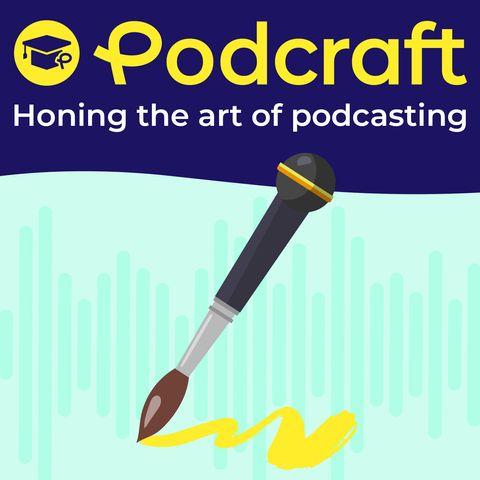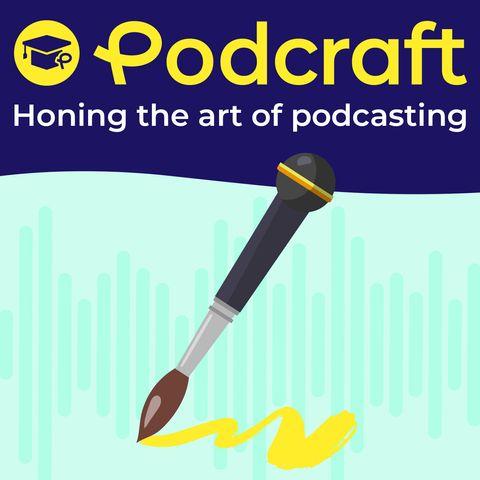
Podcast by Alitu via The Podcast Host

Podcast by Alitu via The Podcast Host

08 December 2025
Fiction podcasts often hold listeners for longer than non-fiction shows. But what can non-fiction creators learn from this?
We break down the simple storytelling tools that keep audiences hooked, including open loops, stronger intros, clearer arcs, and themed seasons. We also highlight some easy wins that improve retention, such as smoother transitions, cleaner audio, and titles that set clearer expectations.
We then dive into a detailed review of a history and policy podcast and explore the lessons it offers for growth. Naming clarity, smarter show notes, and better use of a back catalogue all come up as high-impact opportunities. We also look at ways to reach more listeners through collaborations, community spaces, news-reactive episodes, and in-app promotion. The thread throughout is simple. Strengthen retention first, then build reach with structure, consistency, and relevance.
Mentioned
Podcraft is brought to you by Alitu and The Podcast Host
00:00
44:20

01 December 2025
What if monetising a podcast was simpler than the usual laundry list of tactics suggests? A new model called the Three As breaks earning potential into three clear paths:
The aim is to choose the route that fits your show’s size and purpose rather than copy the strategies used by giants.
Elsewhere, recent Independent Podcaster survey results show creators splitting into two broad groups. Audio-first shows follow flexible production routines, while video-led podcasts often feel the pressure of weekly uploads from platforms like YouTube. These differences show up in formats, production time, and a growing worry that video’s rise could narrow the types of stories podcasters feel able to make.
There is also a look at the event season ahead and how to get more from it. The focus is on going in with clear intentions, using the space to meet potential guests, and treating each venue as a chance to make connections rather than sit through panels all day.
The episode ends with practical studio advice. Creating depth behind you, shaping your light, and mixing fixed and angled shots can all lift your visuals without expensive gear. A bit of planning and a thoughtful layout often matter more than the camera you use.
Podcraft is brought to you by Alitu and The Podcast Host
00:00
51:55

24 November 2025
In this conversation, Colin sits down with Craig Hewitt, founder of Castos, to discuss the shifting landscape of content creation. Fresh off completing a 100 Days of YouTube challenge, Craig shares why he chose video over podcasting during that time, what he learned about platform growth, and the powerful truths about podcast numbers versus engagement (where podcasting still shines!)
They explore the convergence of audio, video, and email platforms, the challenges of monetization in podcasting, how AI is reshaping content workflows (without replacing creators), and why a few hundred engaged podcast listeners might be more valuable than 100,000 YouTube views.
Craig Hewitt - Founder of Castos, a podcast hosting platform. Recently completed 100 Days of AI on YouTube, growing from 250 to 11,000 subscribers. Find him at Castos.com or search "Craig Hewitt" on YouTube.
[00:00] Introduction & Catching Up
[02:15] Has Podcasting Changed More in the Last Year?
[05:30] What is Podcasting in 3-5 Years?
[08:45] Craig's 100 Days of YouTube (And No Podcasting)
[12:20] The Convergence of Content Platforms
[16:00] Product Development: When to Expand vs Focus
[20:45] Spotify as a Video Platform
[25:30] Exclusive APIs and Platform Access
[30:15] What Really Matters in Podcast Software
[35:00] The Monetization Challenge
[42:30] AI in Content Creation
[48:00] Building AI-First Products
[52:15] Craig's AI Learnings from 100 Days
[56:45] Growing on YouTube: Concept is Everything
[62:00] The 800 vs 11,000 Paradox
[66:30] Small Audiences, Big Revenue
"For certain types of people in certain situations, a podcast is by far the most valuable kind of marketing real estate they can have. The rub is that's not everyone or even most people." - Craig Hewitt
"If you have 1,000 podcast listeners, you might convert 500 of them, but if you have 10,000 YouTube watchers, you might still only convert 500 of them." - Colin Gray
Subscribe to PodCraft for more conversations about running a successful podcast in today's evolving content landscape.
00:00
49:49

17 November 2025
Our Indie Podcasters Report shows that once production goes past six hours, audio-only creators are the ones spending the most time in the edit.
But why?
The answer goes beyond workflow. Audio culture has always valued clean mixes, careful pacing, and detailed sound design, so creators tend to polish every moment. Video makers often move faster by embracing jump cuts and a simple top, tail, publish routine.
That doesn't mean video is the easier path. It brings its own challenges, from codec issues and lighting problems to huge file sizes that slow everything down.
In the end, this isn't a contest between formats. It is about understanding the differences so you can choose the approach that suits your skills, your time, and your goals.
We also put our heads together to try and flesh out a USP for Colin's new podcast, discuss gear-related accessibility issues, and look ahead to the upcoming Black Friday deals season.
Also Mentioned
00:00
52:49

10 November 2025
Ever feel like your podcast has started to sound scripted rather than conversational? When the spark fades, it’s time to shake things up. This episode explores how relaxing your format can reignite creativity and flow, why over-scripting kills energy, and how a looser, more natural approach helps you sound sharper and enjoy recording again.
We also dig into some practical podcasting essentials, from Apple’s new AI-generated chapter markers and what they mean for listener engagement, to one of the most powerful habits you can build: listening back to your own episodes. It’s uncomfortable, but it’s the fastest way to improve your delivery, catch unnoticed habits, and sound more confident every time you hit record.
Mentioned
00:00
59:20

03 November 2025
On a recent episode of Podcraft, Neale James of The Photowalk talked about an email he once received from a listener who was housebound due to illness. They wrote that they could no longer go out for walks but hoped their life might change one day. For now, the sounds of Neale’s walks, even his grumbling at passing planes, reminded them that there was still a world out there.
“That message taught me something important,” Neale said. “In a world that is increasingly shaped by AI, authenticity matters. People value the real and unpolished moments more than we sometimes realise.”
'Walkcasting' wasn’t the only reason Neale was able to publish 500 episodes in five years and turn his podcast into a full-time living, but it played a big part.
Even if you are not chasing those kinds of milestones, there is a lesson here. In an era where thousands of fully AI-generated shows flood podcast apps each week, authenticity and human connection have never mattered more. So how can a new podcaster stand out in all that noise?
Neale’s story says a lot about why walkcasting resonates with so many people. There’s something special about hearing someone talk while they’re moving through the world. It feels real, unfiltered, and human. If you’ve never tried recording this way before, here are six reasons to give it a go.
Walkcasts feel more like a conversation than a broadcast. The rhythm of footsteps, the background sounds, and the unpolished tone create a sense of presence, as if you’re right there with the host. Little imperfections, such as a breeze or a passing car, add warmth and texture, reminding listeners they’re sharing a genuine moment with a real person.
That sense of authenticity does more than make a walkcast sound real; it also deepens the emotional bond between host and listener. The gentle movement and surrounding atmosphere make it easy to imagine walking alongside someone. Many listeners find this kind of audio comforting and companionable, especially when they’re out on their own walks or can’t get out for one themselves.
Walking often sparks fresh ideas and clearer expression. It’s easier to talk freely when you’re moving instead of staring at a microphone in a still, silent room. That freedom often leads to more thoughtful, engaging moments, giving listeners a sense of the host thinking out loud rather than reading from a script.
A walkcast takes very little setup. You don’t need a studio or expensive gear, so you can record whenever inspiration strikes. Since it’s meant to sound relaxed, there’s less pressure to polish every word. That simplicity means you can record and publish more often, keeping your connection with listeners alive.
You can make a walkcast with nothing more than a smartphone and a small microphone. You don’t need expensive equipment or complex software, which makes it an easy way for anyone to try podcasting. And because you can record anywhere, it’s easy to capture ideas as they happen instead of waiting for the perfect setup.
Walkcasts stand out because they feel so human. The unique mix of your voice, the pace of your walk, and the sounds around you can become part of your signature style. In an age of slick production and AI-generated content, that lived-in authenticity makes you sound unmistakably yourself.
Recording while walking is good for both body and mind. It turns screen time into fresh air and movement, helping to improve focus and lift mood. The slower rhythm of a walkcast encourages a calmer, more mindful approach to creating content. It offers a gentle alternative to the fast-paced world of digital media.
If you’re already reaching for your coat and lacing your shoes, brilliant. Make the most of that spark before the weather changes its mind.
But you might suddenly worry that you don’t have the right gear or software for a walkcast. The good news is that you probably do. Neale records straight into his smartphone with no external mic. Phone audio has come a long way in recent years, and yours will likely do just fine.
If it is calm outside or you tend to walk in sheltered spots like woodlands, you are good to go. It is worth adding a small windjammer for next time, though, as it will keep your audio clean on breezier days when the trees are dancing.
If you are worried about what to say, a small notepad with 3-5 bullet points is enough to prompt you if you get stuck. If you head out with pages of detailed notes, you might be better off staying behind the desk.
Your phone already has a built-in voice notes or voice memos app, and that's all you need to capture your recordings. You can buy or download other recording apps with extra features, but those are optional rather than essential.
Remember, one of the biggest benefits of walkcasting is how simple it is to set up, so keep things as minimalist as possible. You can always add or adjust later, but don't put off your first recording.
If you can get out for a walk and record even one episode, I’d encourage you to give it a try. At worst, you'll get your steps in for the day.
Think of walkcasting as calling a friend while on the move. A good starting point is to share a few reflections or insights on your last episode or interview. You'll quickly get a feel for what works.
Anecdotally, every walkcasting podcaster I have spoken to says those episodes get the most positive feedback. There is a good chance your listeners will feel the same way, so grab your coat and start recording!
00:00
19:01